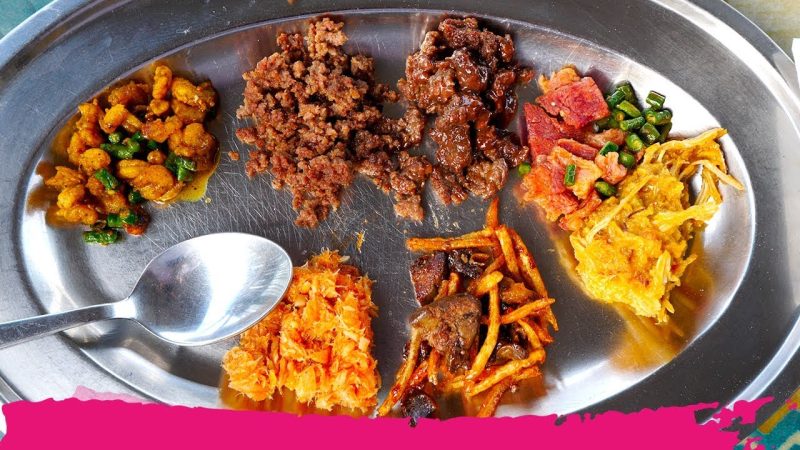Foods of Suriname: Suriname, located on the northeastern coast of South America, boasts an incredible cultural diversity that shines through in its cuisine. Influences from the indigenous Arawak and Carib people, as well as African, European, Indian, Indonesian, Chinese, and Jewish communities, have created a rich culinary tapestry unlike anywhere else in the world. Each dish tells a story of the nation’s history, cultural fusion, and agricultural abundance. In this article, we will explore the top 10 traditional dishes of Suriname that every food lover must try.
Foods of Suriname: Roti with Chicken Curry (Roti Kip)
Roti with chicken curry is one of the most beloved dishes in Suriname, showcasing the Indo-Surinamese influence on the nation’s culinary landscape. Roti, a flatbread with Indian origins, is served alongside a savory chicken curry that’s been slow-cooked with a rich blend of spices like turmeric, cumin, and garam masala. The soft, doughy roti is perfect for scooping up the curry, along with sides like potatoes, chickpeas, and green beans.
This meal is not only a popular street food but also a staple in many Surinamese homes, enjoyed during special occasions and family gatherings. Its flavors are a delightful marriage of the Caribbean and Indian traditions, bringing together heat, fragrance, and warmth in every bite.
Foods of Suriname: Pom
A true national dish of Suriname, Pom is a hearty casserole made with grated pomtayer (a type of root vegetable similar to taro), chicken, citrus juice, and spices. Pom is often served during celebrations, including birthdays and holidays, and is deeply rooted in Creole and Jewish-Surinamese traditions.
What makes Pom unique is the combination of tender chicken baked in a flavorful citrus marinade, then covered with the grated pomtayer mixture. It’s baked until golden brown, creating a crispy top layer and a soft, savory filling underneath. Pom is typically served with rice or bread and is a favorite dish for those seeking comfort food with a twist.
Saoto Soup
Saoto Soup is a popular Javanese-Surinamese dish that has gained widespread appeal throughout Suriname. This fragrant chicken soup is packed with layers of flavor and is often enjoyed as a hearty lunch or dinner. The broth is made from chicken simmered with lemongrass, ginger, garlic, and galangal, giving it a uniquely aromatic flavor profile.
The soup is typically served with shredded chicken, rice noodles, bean sprouts, fried shallots, boiled eggs, and a side of sambal (chili paste) for those who like to add a spicy kick. Saoto is not only delicious but also nutritious, making it a comforting meal that warms both body and soul.
Moksi Meti
For meat lovers, Moksi Meti is an absolute must-try. The name “Moksi Meti” translates to “mixed meat,” and that’s exactly what you get—an indulgent combination of roasted pork, chicken, and sometimes beef. The meats are marinated in a flavorful mix of soy sauce, garlic, and spices before being slow-cooked until tender.
Moksi Meti is usually served with rice, plantains, and vegetables, making it a complete meal. This dish perfectly represents the blend of Chinese and Creole influences in Surinamese cuisine, where savory meats are cooked to perfection and served in generous portions.
Bami Goreng
Bami Goreng, or stir-fried noodles, is another delicious dish that showcases the influence of Javanese immigrants in Suriname. The dish consists of wheat noodles that are stir-fried with garlic, onion, and a variety of vegetables, such as carrots, cabbage, and green beans. It’s often topped with shredded chicken, beef, or shrimp, along with a drizzle of soy sauce and sambal.
Bami Goreng is a quick, tasty meal that can be found in both street food stalls and restaurants across Suriname. It’s beloved for its simplicity and versatility, as it can be adapted with different proteins and spices to suit individual tastes.
Peperpot
One of the oldest and most traditional dishes in Suriname is Peperpot, a slow-cooked stew with roots in the country’s Afro-Surinamese community. Peperpot is made with meat, usually beef or chicken, cooked with cassava, onions, peppers, and a variety of spices like cinnamon and cloves. The key ingredient is cassareep, a thick, dark syrup made from the juice of bitter cassava, which gives the stew its rich, deep flavor.
Peperpot is often served with rice or bread and is known for its bold, spicy, and slightly sweet taste. The stew is cooked slowly to allow the flavors to meld together, creating a dish that’s both comforting and full of history.
Pastei
Pastei is a savory pie that’s a popular dish for parties and special occasions in Suriname. Influenced by Dutch cuisine, Pastei consists of a flaky pastry crust filled with a mixture of chicken, peas, carrots, and sometimes hard-boiled eggs. The filling is seasoned with a blend of spices, including nutmeg, and the pie is baked until golden and crispy.
Pastei can be enjoyed either hot or cold and is often served as a main course or as part of a larger buffet. Its rich, savory filling and crispy pastry make it a crowd-pleaser at any event.
Foods of Suriname:Bojo
For those with a sweet tooth, Bojo is a must-try dessert. This gluten-free cake is made with grated cassava and coconut, mixed with sugar, eggs, and spices like cinnamon and nutmeg. Bojo is baked until it forms a dense, moist cake that’s bursting with tropical flavors.
Bojo is a popular treat in Suriname, often served at celebrations and festive occasions. Its unique texture and combination of cassava and coconut give it a distinct flavor that’s both satisfying and exotic.
Kousenband
Kousenband (yardlong beans) is a common vegetable side dish in Suriname, often served with rice and meat dishes like Moksi Meti or Peperpot. The beans are stir-fried with garlic, onions, and sometimes shrimp or salted fish, creating a simple yet flavorful accompaniment to any meal.
Kousenband is highly nutritious and is a staple in many Surinamese households. Its crunchy texture and savory flavor make it a perfect balance to the richer, meatier dishes that are common in Surinamese cuisine.
Bara
Bara is a popular street food snack in Suriname, influenced by the Indo-Surinamese community. These deep-fried dough balls are made from a mixture of flour, lentils, and spices like cumin, turmeric, and coriander. Bara is typically served with chutneys or spicy sambal, making it a flavorful and satisfying snack.
Bara is crispy on the outside and soft on the inside, with a slightly spicy flavor that pairs well with the tangy chutneys. It’s a favorite among locals and visitors alike and can be found at street food stalls throughout the country.
Conclusion
The foods of Suriname offer a unique and diverse culinary experience that reflects the country’s rich cultural history. From the spicy and savory flavors of Indo-Surinamese and Javanese dishes to the comforting, hearty meals influenced by African and European traditions, Surinamese cuisine has something to offer everyone. Whether you’re enjoying a hearty dish like Pom or indulging in a sweet slice of Bojo, each bite will give you a taste of Suriname’s vibrant and multicultural identity.
FAQs
1. What is the most popular dish in Suriname?
Roti with chicken curry is one of the most popular dishes in Suriname, beloved for its flavorful spices and soft, doughy roti bread.
2. Is Surinamese food spicy?
Surinamese food can be quite spicy, especially dishes influenced by Javanese and Afro-Surinamese traditions. However, the level of spice can often be adjusted based on personal preference.
3. Are there vegetarian options in Surinamese cuisine?
Yes, Surinamese cuisine offers several vegetarian options, such as Kousenband (stir-fried yardlong beans) and Bara (spiced fried dough), as well as curries and rice dishes that can be made without meat.
4. What are some common ingredients used in Surinamese cooking?
Common ingredients include rice, cassava, plantains, beans, chicken, beef, and a wide range of spices such as cumin, turmeric, and garlic.
5. Can I find Surinamese food outside of Suriname?
Yes, Surinamese food can be found in certain restaurants and food markets in the Netherlands, as well as in areas with large Surinamese communities around the world.
Also read: Amsterdam Netherlands Flag: 6 Historical Facts That Will Captivate You









